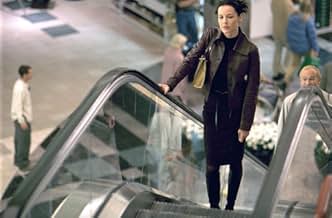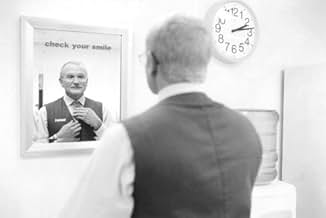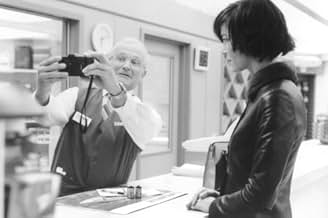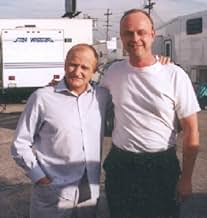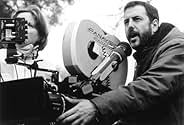Un desarrollador de fotos mentalmente inestable se dirige a una familia de clase media cuando su obsesión con ellos se vuelve más enferma e inquietante de lo que cualquiera de ellos podría i... Leer todoUn desarrollador de fotos mentalmente inestable se dirige a una familia de clase media cuando su obsesión con ellos se vuelve más enferma e inquietante de lo que cualquiera de ellos podría imaginar.Un desarrollador de fotos mentalmente inestable se dirige a una familia de clase media cuando su obsesión con ellos se vuelve más enferma e inquietante de lo que cualquiera de ellos podría imaginar.
- Dirección
- Guionista
- Elenco
- Premios
- 6 premios ganados y 22 nominaciones en total
- Yoshi Araki
- (as Paul Hansen Kim)
- Officer Lyon
- (as Andrew A. Rolfes)
- Dirección
- Guionista
- Todo el elenco y el equipo
- Producción, taquilla y más en IMDbPro
Opiniones destacadas
the directors (romanek) flair for colour synchronicity and immaculate art direction does not stray far from his beginnings as a music video director, however it is this attention to detail and precision that accentuates williams when he chooses to lose the plot. a memorable scene in the film of william's characters eyes squirting blood is in stark contrast to the ordered white formica and polished chrome surfaces that intimate to the spectator a feeling of staring intently at snapshots of a desperate man's life.
if this film was to have any criticism is in the roles of the supporting actors. they are hardly fleshed out and as a spectator i felt that at times i was watching the robin william's rebirth show, however this is a minor point. if i were to mark this out of 10 i would give it a strong 8.
I saw this film in a free preview screening before it came out so I had no reviews to cloud me first. Happily most of them appear to feel the same as I did. In terms of plot this set up will be no surprise to anyone we've all seen Single White Female and Pacific Heights etc, we know what happens that leads to the old bunny boiling etc.
However One Hour Photo is different enough to justify watching. My wife complained that it was too slow and boring but I felt this approach helped it stand out. Instead of being a thriller it was more of a cold slow boiler than was more chilling than thrilling. The plot is well laid out even the money shot of all the pictures on the wall is played out while we're distracted by a joke from the Simpsons on TV. The director's cold approach to story telling works very well and highlights Seymour's grey existence and cold life. Only occasionally does he go astray the fantasy sequences don't always work for instance but for almost the whole film he does very well.
Towards the end Seymour's behaviour goes erratic as we expect and I was worried that the film had eventually given way to cliché. Happily this is not the case. Yes, Seymour's change is a bit of a leap at first but the film cleverly pulls it back at the end. This makes it above the rest of this genre by a good head and shoulders. Clever touches abound in the film but don't always work. For example the director shows us that it is all about seeing by covering Seymour's eyes with objects in some shots to show he has lost his ability to watch, while the name Yorkin is a slight play on `Your Kin' or your family. These are clever but don't add very much the eye theme felt a bit too clever and intrusive.
Williams is excellent. Having paid to see him mush around in Patch Adams I was worried here that eventually his emotions would run away with him. However Williams (and here's something you'd won't hear much) keeps it all in check and underplays wonderfully. His Seymour is likeable, sad, pathetic and chilling all at once. It's hard not to feel for him and he is better for being low-key. I truly felt Williams had turned himself into a `little' man one of those people who you barely notice on the streets as they make no lasting image. Vartan (Alias) is good as Will and Nielsen is also good as Nina. They are also given firm support in the shape of Gary Cole and La Salle. However his is Williams show and, by underplaying, he steals it easily.
Overall this has it's flaws but it is head and shoulders above the rest of this stalker genre. Directed with a clinic eye rather than a thrilling eye this is clever and different enough to more than justify checking it out.
Romanek understands that the greatest threats to our safety and lives often come from the gray, nondescript people who surround us unnoticed, the `nobodies' whose benign faces and vacuous smiles reveal no trace of the insanity, evil and potential for doing us harm that may be lurking right there under the surface. And nobody is `grayer' than Si Parrish, an innocuous, socially undeveloped milquetoast who spends his days working as a photo developer in one of those sterile five-and-dime drug stores (just like the one in `The Good Girl') - and his nights sitting all alone in his drab apartment brooding over a massive family-photo shrine he has erected to the Yorkins, a seemingly happy family of three whose pictures Si has been developing, copying and obsessing over for more than seven years now. The film centers around Si's growing fixation with this one family and his delusional belief that he too could somehow become an integral part of their family unit. Then comes the day when Si realizes that he is no longer content to be a mere vicarious member of this adopted family and, thus, begins his plan to gradually insinuate himself more and more directly into their lives.
As both writer and director, Romanek manages to keep us in a state of vague uneasiness throughout. We are always anticipating some potentially dreadful event, yet Romanek doesn't go for the easy thrill or the obvious plot turn. Thanks to Williams' subtle, incisive performance, we come to understand something of what makes this strange character tick. We begin to sense the deep-seated loneliness and social awkwardness that have come to play such an important part in defining both his behavior and his character. Si is scary, but he is also pathetic. He may have slipped over the edge into madness, but it is a pathology rooted in overwhelming loneliness and the inability to `fit in' to the societal `norm' of marriage and family. Even when his character is at his most threatening and irrational, Williams somehow makes us care about him.
Romanek hits upon a few ancillary themes as well. He acknowledges how photos create the appearance of a life without necessarily reflecting the reality of that life. Most people, Si confesses, record only the `special, happy' moments of their lives birthdays, weddings, holidays etc. and leave out the mundane or painful ones. Moreover, Si tells us that people use pictures as a way of defeating aging and time, of saying to the world of the future that `I', this seemingly insignificant person, was really here, being happy and enjoying life. To match this theme, Romanek's visual style often feels like the director's own personal homage to The Photograph, as the camera scans caressingly across a sea of snapshots and Si's voiceover narration complements that feeling.
`One Hour Photo' is not a film for those who like their chills heavily laced with bloodshed, murder and mayhem. It is, rather, for those who can appreciate a quietly unsettling, yet strangely compassionate glimpse into the dark recesses of the troubled mind.
¿Sabías que…?
- TriviaAfter the film premiered at the Sundance Film Festival, Robin Williams overheard viewers say that they forgot it was Williams in the lead role 15 minutes into the film. An observation that made Williams proud.
- ErroresRed light is added by the filmmakers to show the film moving through the developing machine. Color film is sensitive to all light, therefore all of that film would be fogged. Red light is only used for black and white paper print developing.
- Citas
Sy Parrish: And if these pictures have anything important to say to future generations, it's this... I was here. I existed. I was young. I was happy... and someone cared enough about me in this world to take my picture.
- Versiones alternativasAn early cut of the film had several differences than the theatrical version.
- The opening Fox Searchlight logo briefly becomes a negative image as it fades out. This is obviously a reference to picture negatives.
- An alternate prologue before the main titles featured a narration by Williams on the red eye effect in human's and animals, while a photo of a family with red eyes, footage of animals with this effect and video of what's happening in the eye when this happens.
- There was also a scene near the end where a police detective reviews the pictures Sy took of Will & Maya at the hotel. In the theatrical version these photos were never shown and it was left in question whether they were actually taken.
- The argument between Sy and the photo machine repair guy was extended.
- ConexionesFeatured in Anatomy of a Scene: One Hour Photo (2002)
- Bandas sonorasComing Home
Written by William Aura, Craig Dobbin, and Alain Eskinasi
Performed by 3rd Force
Courtesy of Higher Octave Music
Selecciones populares
Everything New on Hulu in August
Everything New on Hulu in August
Detalles
- Fecha de lanzamiento
- País de origen
- Idioma
- También se conoce como
- One Hour Photo
- Locaciones de filmación
- Brentwood, Los Ángeles, California, Estados Unidos(Yorkin house)
- Productoras
- Ver más créditos de la compañía en IMDbPro
Taquilla
- Presupuesto
- USD 12,000,000 (estimado)
- Total en EE. UU. y Canadá
- USD 31,597,131
- Fin de semana de estreno en EE. UU. y Canadá
- USD 321,515
- 25 ago 2002
- Total a nivel mundial
- USD 52,223,306



